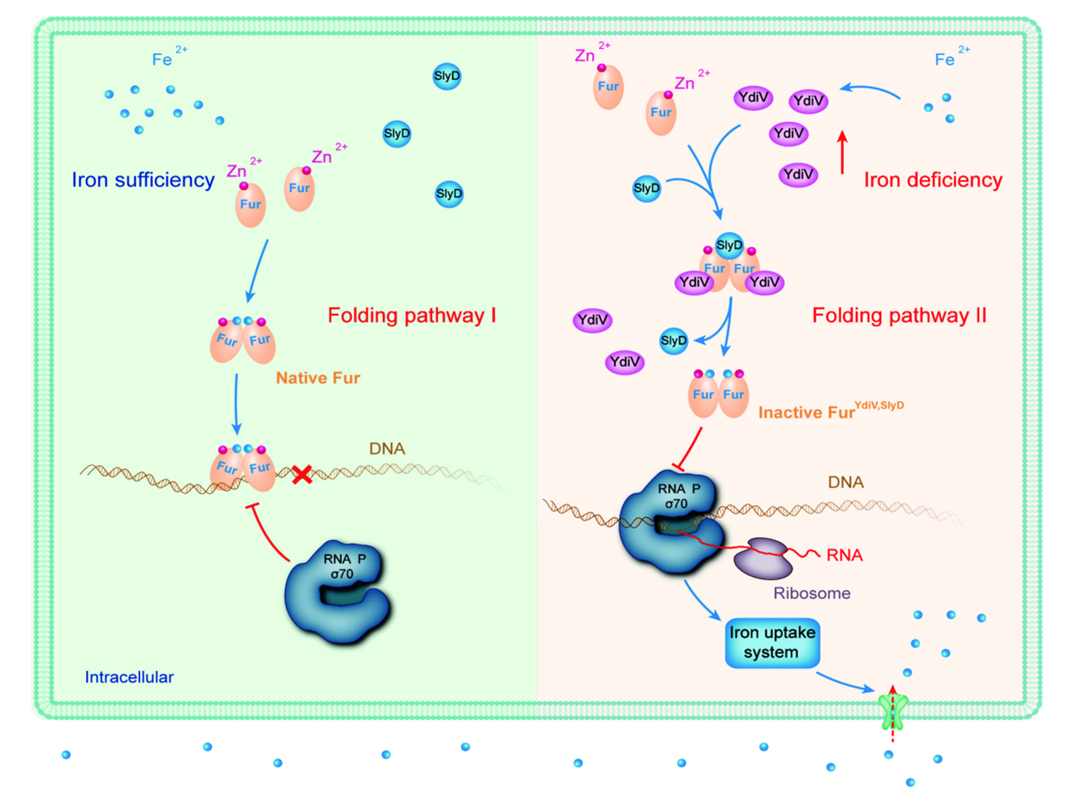Recently, Prof. Gu Lichuan's group, from the State Key Laboratory of Microbial Technology of Shandong University, made new progress in bacterial iron metabolism regulation. Related research article was published on the international top journal Nucleic Acids Research entitled "YdiV regulates Escherichia coliferric uptake by manipulating the DNA-binding ability of Fur in a SlyD-dependent manner" (IF=11.797). Ph.D. candidate Zhang Fengyu from State Key Laboratory of Microbial Technology is the first author, and Prof.Gu Lichuan is the corresponding authorof the article.
Iron is an essential element for bacteria growth and plays an important role in bacterial pathogenicity due to the host nutritional immunity. In Escherichia coli, the intracellular iron homeostasis is tightly regulated by the ferric uptake regulator Fur. In the widely accepted model, at high iron concentration, dimeric Fe2+-Fur binding with Fur box DNA upstream of the target genes’promoter, which makes the target genes’ promoter inaccessible to RNA polymerase and turns off iron acquisition genes expression. However, how Fur activates the iron-uptake system during iron deficiency is not fully elucidated.
In this study, authors found that YdiV, the flagella gene inhibitor, is involved in iron homeostasis in Escherichia coli. Iron deficiency triggers overexpression of YdiV. High levels of YdiV then transforms Fur into a novel form which does not bind DNA in a peptidyl-prolyl cis-trans isomerase SlyD dependent manner. Thus, the cooperation of YdiV, SlyD, and Fur activates the gene expression of iron-uptake systems under conditions of iron deficiency. Bacterial invasion assays also demonstrated that both ydiV and sly Dare necessary for the survival and growth of uropathogenic E. coliin bladder epithelial cells. This reveals a mechanism where YdiV not only represses flagella expression to make E. coli invisible to the host immune system, but it also promotes iron acquisition to help E. coli overcome host nutritional immunity.

This work was supported by the National Natural Science Foundation of China Grant [31970043]; and the National Basic Research Program of China (973 Program) [2015CB150600]. Prof. Gu Lichuan’s group has been working on the function of YdiV and its homologous proteins for many years. Relevant results were all published in the journal of Nucleic Acids Research (NAR 2012, 40, 11073-11085; NAR 2017, 45, 9976-9989). This article is another important research progress in the field of microbial flagella regulation and ion metabolism.
The links of papers:https://academic.oup.com/nar/article/48/17/9571/5894414
Written by: Fengyu Zhang
Edited by: Che Huiqing